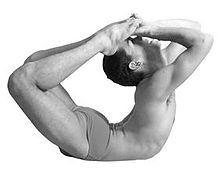Dhanurasana
[5] The pose is illustrated in half-tone in the 1905 Yogasopana Purvacatuska and named Dhanurāsana, quoting the Gheranda Samhita's description.[6] It is unclear whether the asana is medieval, as although the name is used, the intended pose might be the sitting Akarna Dhanurasana rather than this backbend.The account of Dhanurasana in the 15th century Hatha Yoga Pradipika is ambiguous about whether the pose is reclining or sitting, stating[1] Having held the big toes of both feet with both hands, one should pull [them] like a bow as far as the ears.(HYP 1.25)The 17th century Gheranda Samhita is similarly ambiguous, stating Spreading the legs on the ground, straight like a stick, and catching hold of the feet with the hands, and making the body bent like a bow, is called by the Yogis the Dhanurasana or Bow-posture.[8] From a prone position, the feet are grasped to lift the legs and chest to form the shape of a bow with the body, with the arms representing the bowstring.


Sanskritromanizedhatha yogayoga as exerciseHalf-toneYogasopana PurvacatuskaGheranda SamhitaSritattvanidhiAkarna DhanurasanaHatha Yoga PradipikaBharatanatyambowstringBalasanabackbendHalasanaSarvangasanaSalabhasanaUrdhva DhanurasanaBirch, JasonYoga JournalVasu, Srisa ChandraIyengar, B. K. S.Light on Yoga: Yoga DipikaSjoman, Norman E.Vishnudevananda, SwamiThe Complete Illustrated Book of YogaAsanasDrishtiPranayamaSun SalutationVinyasaYoga as therapyAnjaneyasana (crescent moon)Bidalasana (cat)/Bitilasana (cow)Bhujangasana (cobra)Chakrasana (wheel) or Urdhva Dhanurasana (upward bow)Viparita Dandasana (inverted staff)Kapotasana (pigeon)Eka Pada Rajakapotasana (king pigeon)Ushtrasana (camel)Ashtavakrasana (8-angled)Bakasana (crane) or Kakasana (crow)Koundinyasana (the sage Kaundinya)Kukkutasana (cockerel)Mayurasana (peacock)Tittibhasana (firefly)Adho Mukha Svanasana (downward dog)Adho Mukha Vrkshasana (handstand)Halasana (plough)Sarvangasana (shoulderstand)Setu Bandha Sarvangasana (bridge)Shirshasana (headstand)Viparita Karani (legs up the wall)Vrischikasana (scorpion)Anantasana (Vishnu's couch)Ashtanga Namaskara (eight-limbed)Bhekasana (frog)Chaturanga Dandasana (low plank)Jathara Parivartanasana (belly twist)Makarasana (crocodile)Matsyasana (fish)Shalabhasana (locust)Shavasana (corpse)Vasishtasana (side plank)Yoganidrasana (yogic sleep)MeditationBaddha Konasana (cobbler)Gomukhasana (cow face)Gorakshasana (cowherd)Padmasana (lotus)Siddhasana (accomplished)Simhasana (lion)Vajrasana (thunderbolt)Bharadvajasana (the sage Bharadvaja)Marichyasana (the sage Marichi)Matsyendrasana (the sage Matsyendra, lord of the fishes)Pashasana (noose)Akarna Dhanurasana (shooting bow)Balasana (child)Garbha Pindasana (embryo in womb)Hanumanasana (monkey)Kraunchasana (heron)Kurmasana (tortoise)Malasana (garland)Mandukasana (frog)Mulabandhasana (root lock)Navasana (boat)Paschimottanasana (seated forward bend)Samakonasana (split)Virasana (hero)StandingParighasana (gate)Parshvottanasana (intense side stretch)Prasarita Padottanasana (wide stance forward bend)Tadasana (mountain)Trikonasana (triangle)Utkatasana (powerful)Uttanasana (standing forward bend)Utthita Parshvakonasana (sideways)Virabhadrasana (warrior)Ardha Chandrasana (half moon)Durvasasana (the sage Durvasa)Garudasana (eagle)Natarajasana (lord of the dance)Utthita Padangusthasana (standing big toe hold)Vrikshasana (tree)List of asanasStanding asanasDownward dogLotus positionMeditation seatsTree poseWarriorNamasteVinyāsaHasta VinyasasTeacher trainingBritish Wheel of YogaEuropean Union of YogaAndré Van LysebethYoga AllianceTherapyYoga using propsAccessible yogaTrauma-sensitive yogaRestorative Yoga